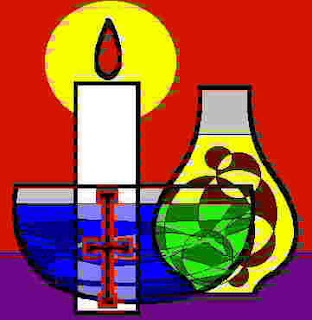“A genuinely good heart is a heart that is open and alight with understanding. It listens to the sorrows of the world. Our society is wrong to think that happiness depends on fulfilling one's own wants and desires. That is why our society is so miserable...” (Jetsunma Tenzin Palmo, Into the Heart of Life, Snow Lion: 2011, Chapter 9 ‘Practicing the good heart’)
Saturday, April 3, 2010
"This Is the Night": The Great Vigil
An annual celebration of the Lord's resurrection goes back to the first generation of Christianity. For the first three centuries this was the only feast observed throughout the Church. This original celebration of what would become Easter was done by way of a vigil (vigilia = a watch or waiting) during the night hours. Christians celebrated their religious experience of a Christ victorious over death and sin, and their victory along with his. It was during those dark hours, turning into the first day of the week, that this mystery had occurred.
With some modifications, especially in length, today's renewed ritual echoes that of early centuries. As soon as the evening star became visible, the night-long rite began. The first hours were spent in reading Scripture and in prayer. The readings from Scripture, usually twelve in all, emphasized a prophetic theme of a new creation and salvation through water: the story of creation, the fall, the flood, the sacrifice of Isaac, the Passover, the crossing of the "Reed" Sea, and the entry into the Promised Land.
As the hours of the night unfolded, this theme was ritualized in a new creation through the waters of baptism, especially the baptism of adults. This rite, which gave a distinct theme to the Easter Vigil, began with a solemn blessing of Easter water, accompanied by the chanting of the Litany of the Saints, by plunging the Paschal Candle into the water, and by mixing it with holy oil. Then the catechumens, those who had been in preparation, sometimes for years, renounced Satan's influence on their former lives, confessed their faith, and were baptized, anointed, and dressed in white robes. By the 5th century, in the Roman Church, a second anointing, or chrismation, was done by the bishop, later evolving into the sacrament of Confirmation.
During the first centuries it was a tradition to give blessed milk and honey to those newly baptized, a gesture symbolizing that the "neophytes" were infants in the faith. It also signified their having been led by God to cross over into the land of promise: the land "flowing with milk and honey". This practice, marking an important life transition, was borrowed from pagan mystery cults.
Finally, as dawn approached, the newly baptized shared the Eucharist, Christ's body and blood, for the first time with the whole community of believers.
An impressive blessing and lighting of the new fire begins The Great Vigil of Easter. In previous times it had a practical purpose: the lamps in church used to be extinguished on Maundy Thursday. Consequently, a new fire had to be lit for the celebrant and readers to see by. The lighting of the Paschal Candle seems to have originated in the ancient daily ritual of Lucernare (lighting of the lamps), as darkness fell. The tradition of lighting candles held by participants began in Rome in the early centuries. The dark of night was filled with candles symbolic of the Risen Christ.
In the Frankish kingdom, further symbolism was added to the Paschal Candle and continues today at the discretion of the celebrant. A cross is cut or traced into the candle, with the proclamation: "Christ yesterday and today, the beginning and the end," adding the first and last letters of the Greek alphabet, "Alpha and Omega". The numbers of the current year are added in the four angles of the crossbars, with the proclamation: "All time belongs to him and all the ages: to him be glory and power through every age forever. Amen." Four grains of incense, sealed with red wax nails, are inserted at the ends of the crossbars and one is inserted where the crossbars meet, with the words: "By his holy...and glorious wounds...may Christ our Lord...guard us...and keep us. Amen."
Subscribe to:
Post Comments (Atom)


No comments:
Post a Comment